In February Dimitris Vavylis, the Greek conservationist and photographer, visited Messolonghi and other wetlands of Western Greece aiming to shoot the gorgeous Dalmatian pelicans, their protected habitats, local communities, and more. Read the exciting blog of the photographer about the mission and of course enjoy the great photos from the region.
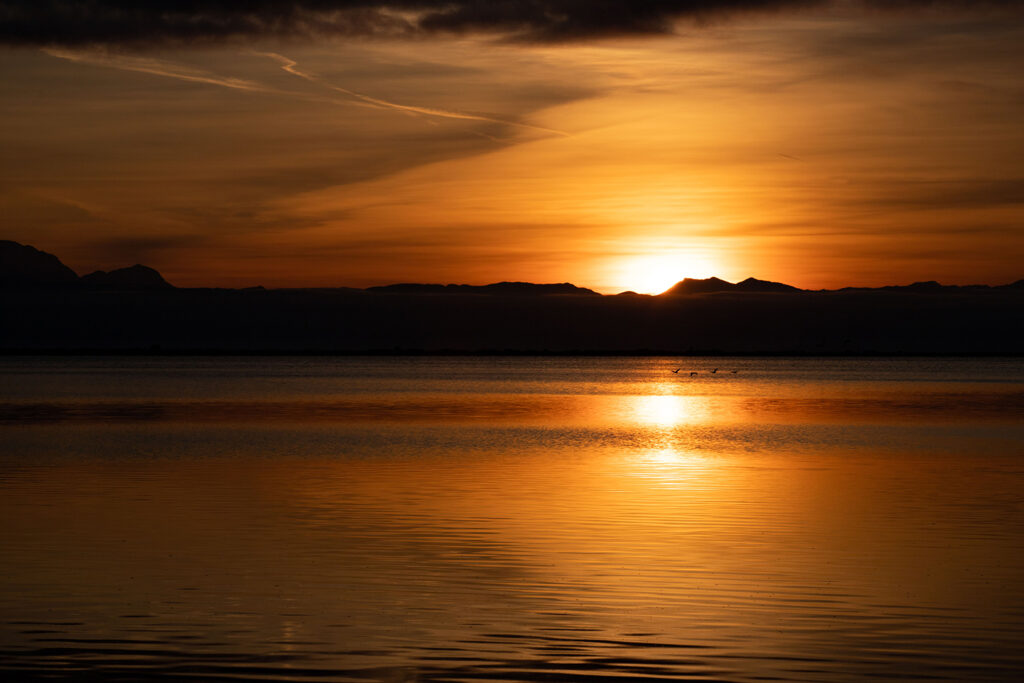
It was Sunday the 6th of February and I was about to begin my one-week adventure at the wetlands of Western Greece. My photographic target was the elusive Dalmatian Pelican but this time I was not looking for close-ups. Instead, I wanted to show the species in its habitat and also to explore its connections with the wetland and the people that share the same waters, like the fishermen.
I started packing in the morning but since I was traveling by car and I didn’t have the weight limit that usually photographers face due to airplane travel, I got “greedy” and quickly I just had too much stuff. Two main cameras and one as reserve, lenses, chargers, trap camera equipment, boots, three pairs of shoes, clothes for a weather range from -30 to +30, I even carried a small aquarium with me… The time flew by and I had to rush.
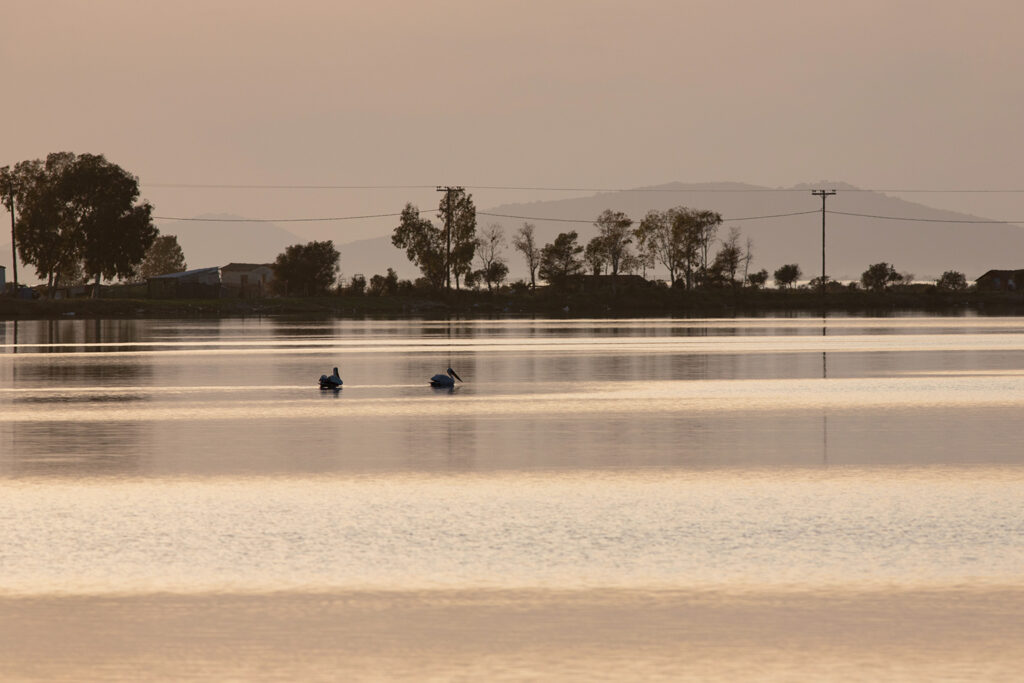
I arrived at Messolonghi just before sunset. Almost immediately I saw my first Pelicans inside the lagoon of Plostena next to the town, quite distant but “dressed” in the nice evening light. I took some shots but they flew away shortly. A Slender-billed Gull was fishing just in front of me and I couldn’t resist, so I also pointed my lens to him. At dusk, I noticed that there were some Flamingos next to the road, and the walkers passed by them without even care. I took advantage of the opportunity and took some walker-Flamingo shots but I wanted to repeat the same frame, this time with a Pelican. So in the following days every time that I passed by this spot I was checking if there was a Pelican until my last day that there was one…
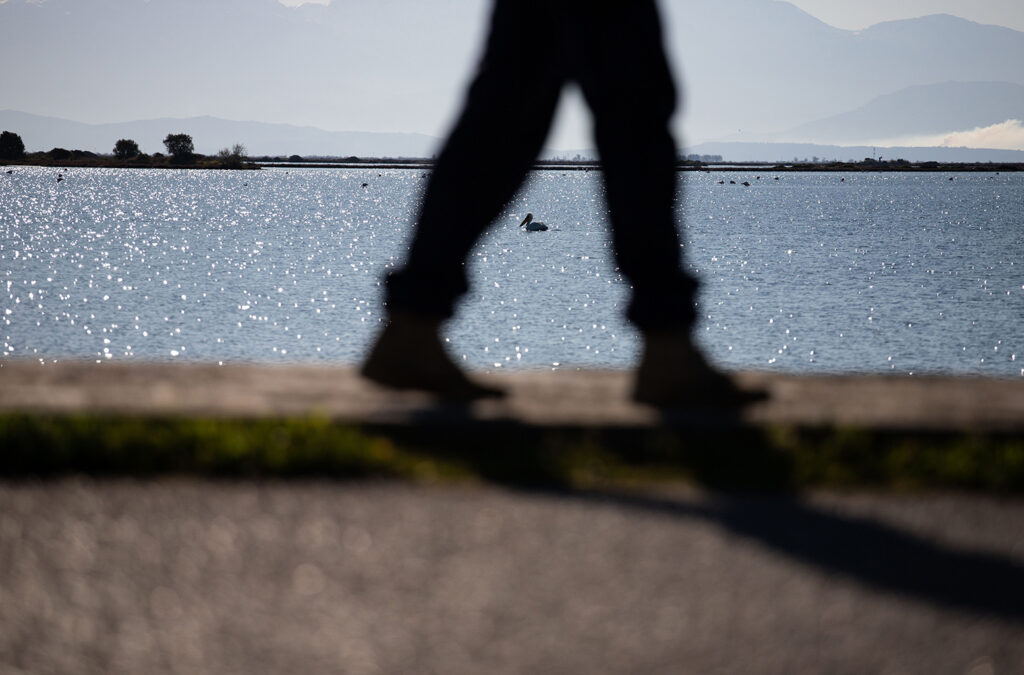
I settled at my hotel, charged my batteries, cleaned the equipment but before going to sleep I had to take a walk at the graphic town and of course, grab a bite. During dinner, I met with Nikos Noulas, the local field ornithologist of Hellenic Ornithological Society (HOS/BirdLife Greece). Nikos has a deep knowledge of the area and together we made a plan for the following days after I explained to him the shots I had in my mind. The mission had just started but I was simultaneously feeling excited but also nervous about the “planned shots”.
The first morning I woke up early or I should say too early. I had set my alarm at 5:00 and I realized that I had almost two hours before the civil twilight starts. Fortunately, I had my macchinetta espresso maker with me, so I enjoyed a nice coffee on the balcony under the chorus of the European Tree Frogs. The sky was quite cloudy and I couldn’t find any Pelicans so I took some landscape shots including the traditional fishermen stilt houses called “Peladas ”.
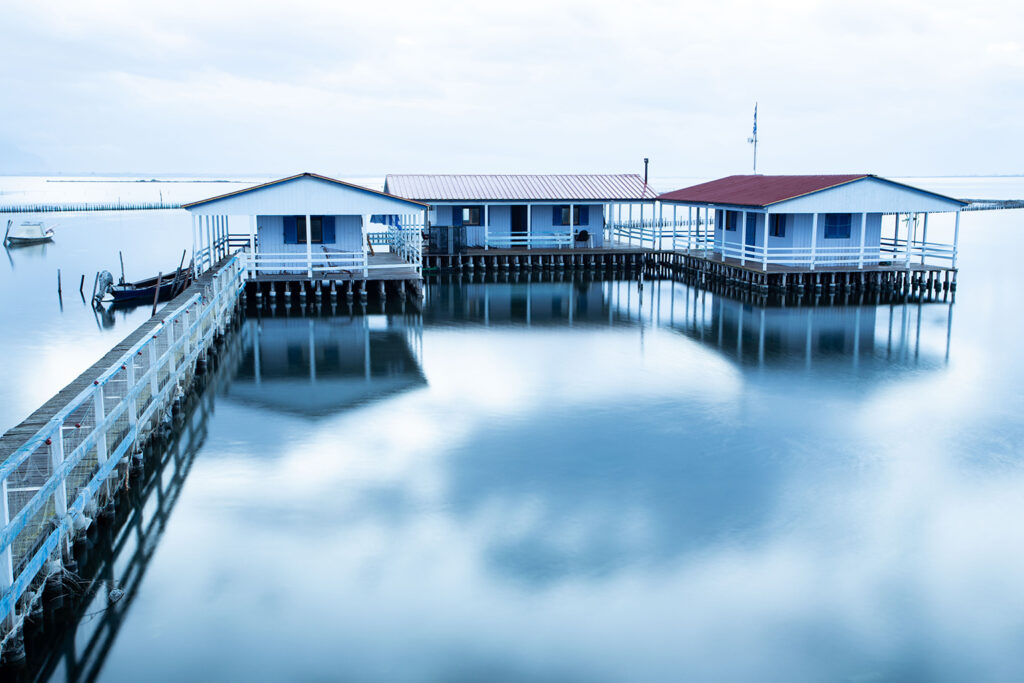
This morning a remote census via drone was scheduled and I wanted to cover it. So while we (Nikos and me) were waiting for the specialized staff of HOS to arrive from Athens, I took the opportunity and visited some of the fish markets of the town to take a first taste of the wealth – the fish of the lagoons. European Eel, Sea Βream, Sea Bass, and Grey Mullet are the main commercial fish of the lagoons of the area. Also, these days were considered “Goby season”, so for the first time in my life I saw Gobies for sale at a fish market and according to the locals they are considered a special delicatessen.
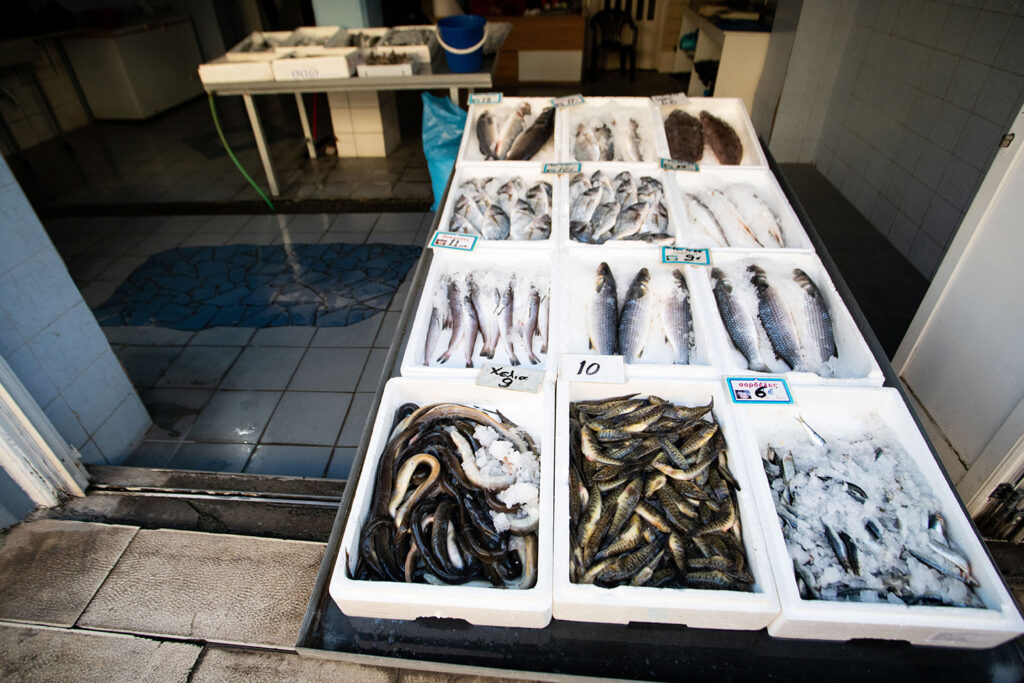
Soon after, Manolia and Aris, the HOS scientists, arrived and we went on board a small fishing boat. One of the two Pelican colonies of the area is situated in the center of the western part of the wetland, well isolated from humans. I realized that even though I have visited Messolonghi many times in the past, I didn’t know the exact location of the colonies and why should I, this part of the life of the birds is private and we should always “keep our safe distance”. So we stopped the boat at a safe distance and Aris took off the drone from the deck with great skill. The drone flew above the colony at a height that it didn’t disturb the birds and took valuable footage. Around 150 pairs of Pelicans breed at the two colonies of Messolonghi but the exact number, as well as other breeding parameters, will be available when this drone footage is analyzed. The scientists will repeat the procedure two more times during the breeding season according to the monitoring protocol that they follow. The first day was over, I got some nice conservation monitoring footage but almost no Pelicans…
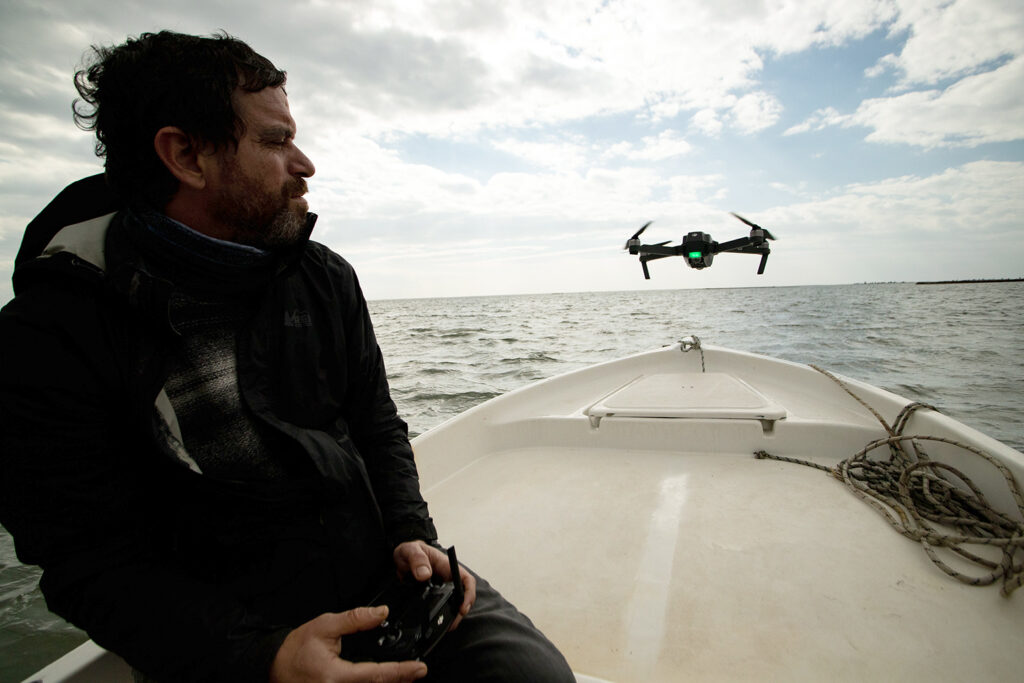
The second sunrise was also partly clouded. And even though I managed to find a small group of Pelicans in Klisova lagoon, they were too far away, even for the “animals in their environment” shots I had in mind. The next stop of the day was an electricity line that runs through the wetland near Etoliko. Nikos has found a dead Pelican there some months ago. Electrocution and collision with electrical wires is one major threat for the species. When we arrived at the spot, I was expecting to find some remains of the bird but it seemed that I was running low on luck until Nikos found some feathers and after searching for a while, we found the bones and the skull of the bird. I placed the skull on some glasswort under the electricity line that killed it. Over the years as a photographer, I have taken pictures of many dead creatures, a sad duty that every conservation photographer must endure. So I took some pictures of the lifeless skull of the Pelican, hoping that they can work as an advocate for safer electricity lines in the future…
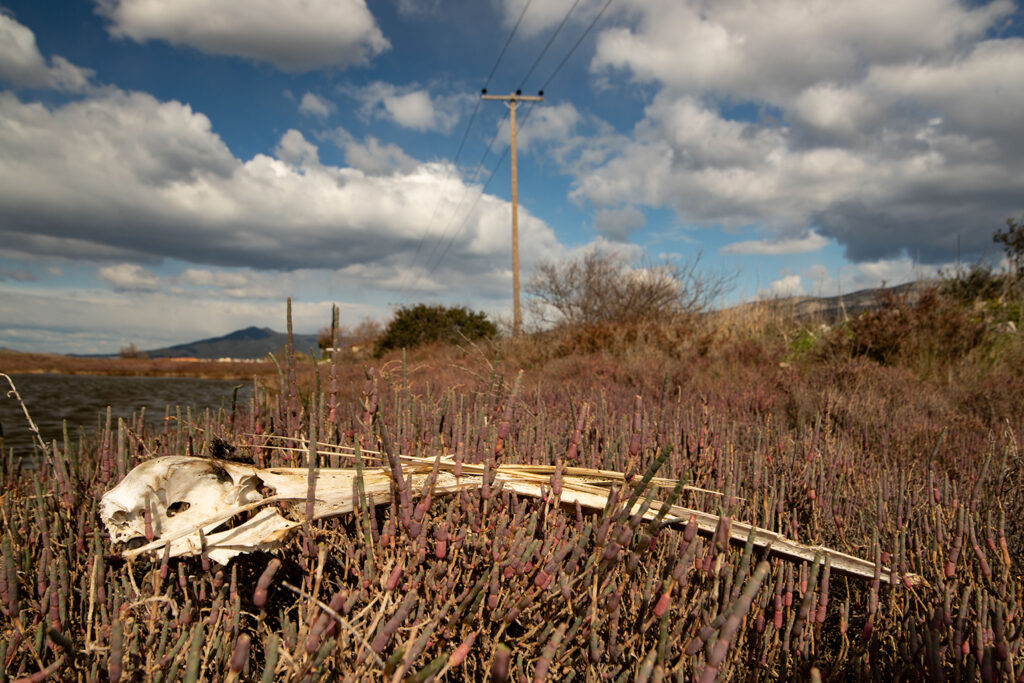
Our next stop took us to the saltpans of Messolonghi, the biggest saltpans of Greece that produce 80% of the national salt quantity. Saltpans are generally calm places and the Dalmatian Pelicans use them as roosting places. For another time I found no pelicans and moreover, I didn’t even find a Pelican’s footprint in the mud that I was searching for. But a visit to the saltpans is always spectacular and also I could feel my luck changing…
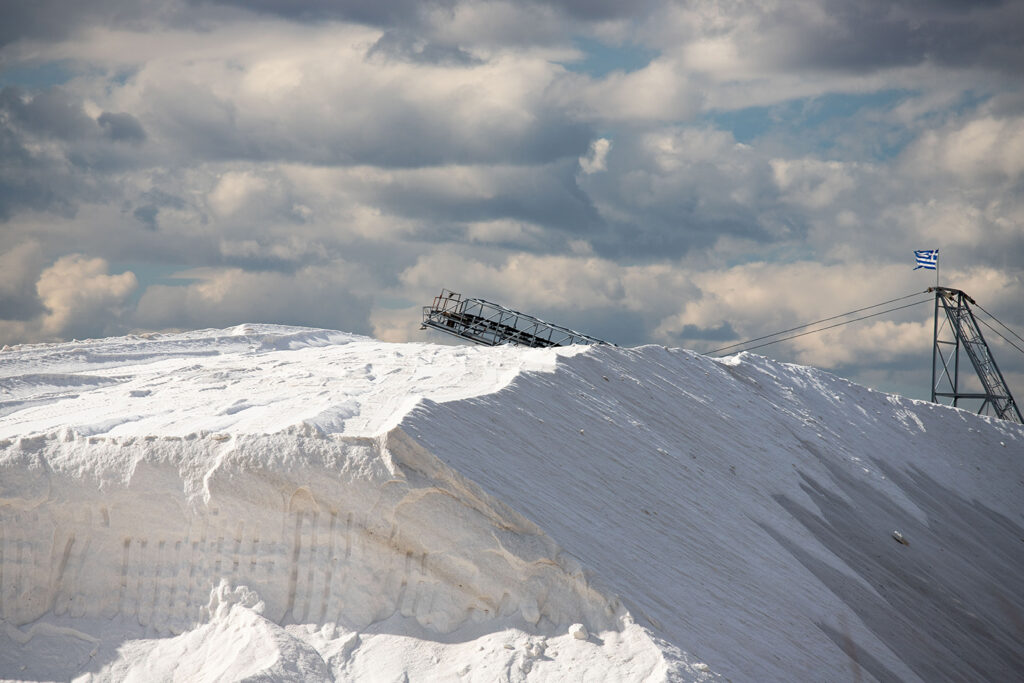
On my 3rd morning finally, I had a clear sunrise, and guess what, the Pelicans were there! While I was waiting for the sun to rise behind the majestic rock of Varasova, a group of Pelicans was feeding at a reasonable distance from me in the lagoon of Klisova. That way I “ticked” the silhouette shots I had in my bucket list and moreover, I got some early morning flight shots as more birds arrived to feed. I was quite happy with the way the day has started so I didn’t mind much when my car refused to start. Some kind of engine start problem that magically disappeared some days later (my best guess is that the key was demagnetized from its hanging carabiner). So I drove my car to a repair shop and Nikos with his car was there to save the day.
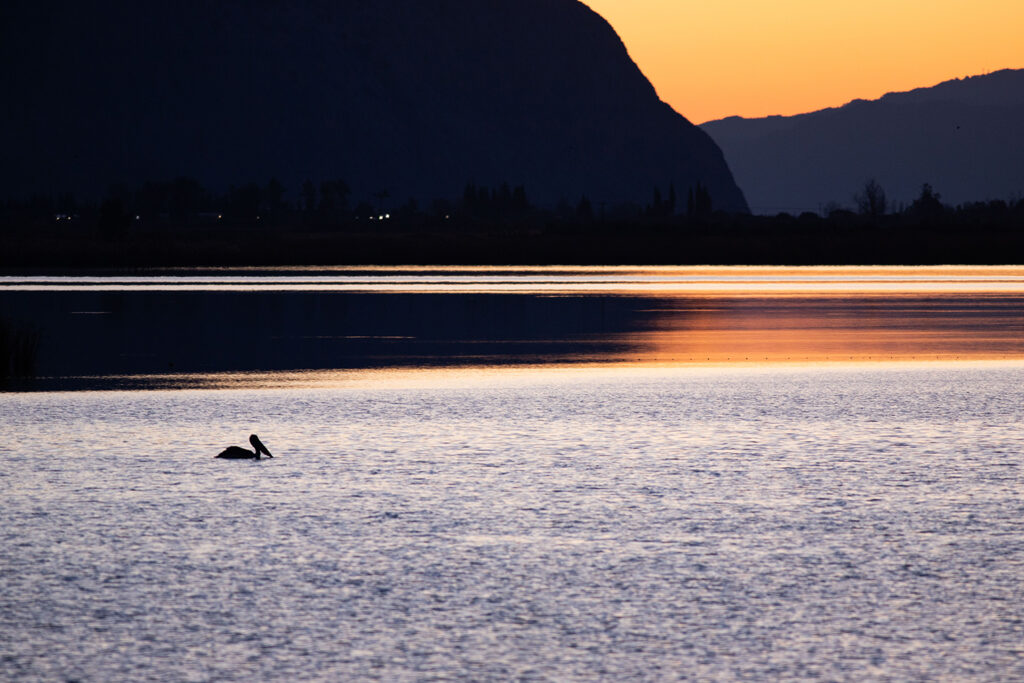
We returned to Klisova and we bumped into two fishermen that were preparing to collect their nets. I asked politely and they allowed me to go onboard. I witnessed first handed the wealth of the lagoon, while the net was pulled from the waters. The main catch was Grey Mullets which was the target fish, some carps (of low commercial value but the favorite food of the Pelicans in the area), and even the endemic catfish Silurus aristotelis, that was released by the fishermen back to the water. I asked the fishermen if they see the Pelicans as competitors and they replied “There is enough catch in the lagoon for both of us”. But my human-nature shots were far from over.
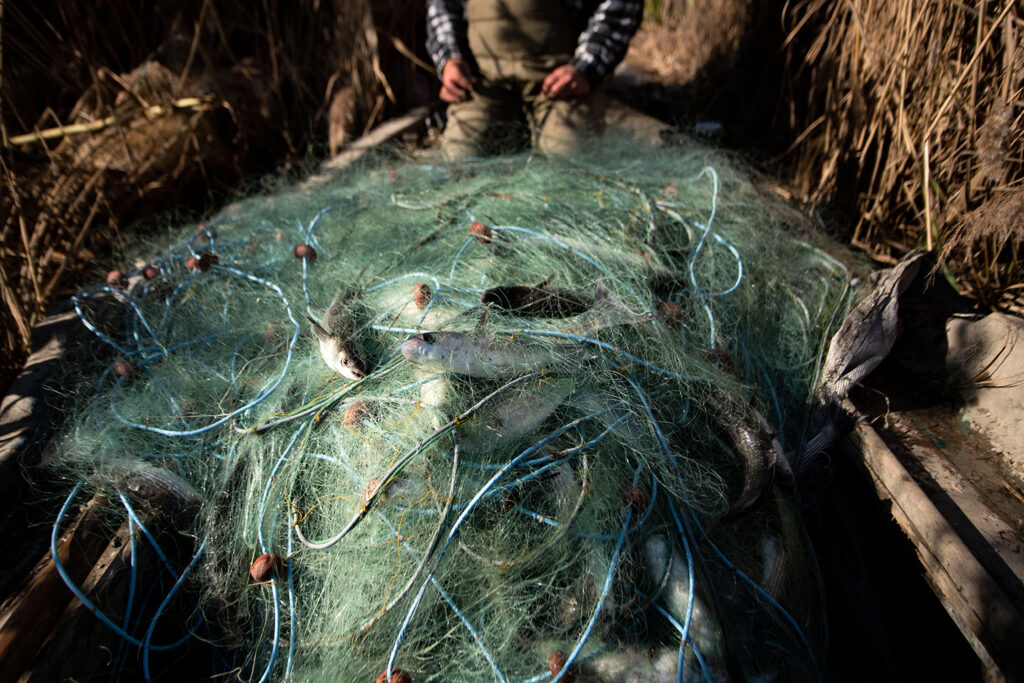
My next stop was at a traditional shop that shells the so-called “gold of the lagoon” the famous Messolonghi botargo or “Avgotaracho” as it is called in Greek. Avgotaracho is made from Grey Mullet eggs that are salted with high-quality salt and enclosed in a natural wax case and it has a very sea-like taste. This sea delicatessen can be sold up to 400E per kilo and it’s one of the super-values the healthy lagoon can offer. The fishermen told me that they want the Grey Mullets to be fished sustainably so that future generations can have “Avgotaracho ”.
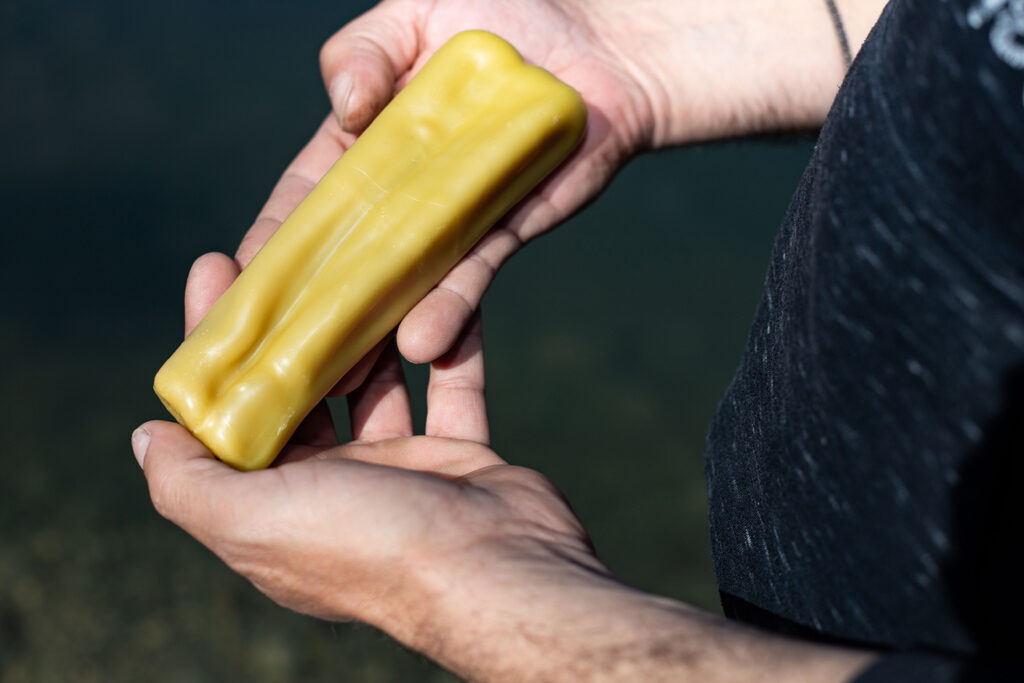
After the session at the botargo shop, I wanted to visit the source or else the place where the big female Grey Mullets are caught. The fishing system in the lagoons is quite interesting. Every entrance of saltwater into the lagoon is controlled by barriers and a summation of barriers creates a formation called “ivari”. Early in spring the fishermen that have leased the ivari from the state or the municipality open the gates so that fish from the open sea enter the brackish water of the lagoon. Then around May the gates close and the fish stay inside the lagoon, in a form of the extensive natural fish farm. At each water entrance, the fishermen place downstream traps so that the fish that try to cross from the lagoon to the sea get trapped there and collected on a daily base. I was welcomed by a family of fishermen that run an ivari and they showed me the traps, but since it’s the low season before the opening of the gates only a few fish were found in the trap that they were released back to the water. I had a long chat with the fishermen and they shared with me stories from the past, and their fears for the future since the low price of fish and the increase in expenses such as fuels make their living harder and harder. At least they said that the wetland is rich and that it will look after them.
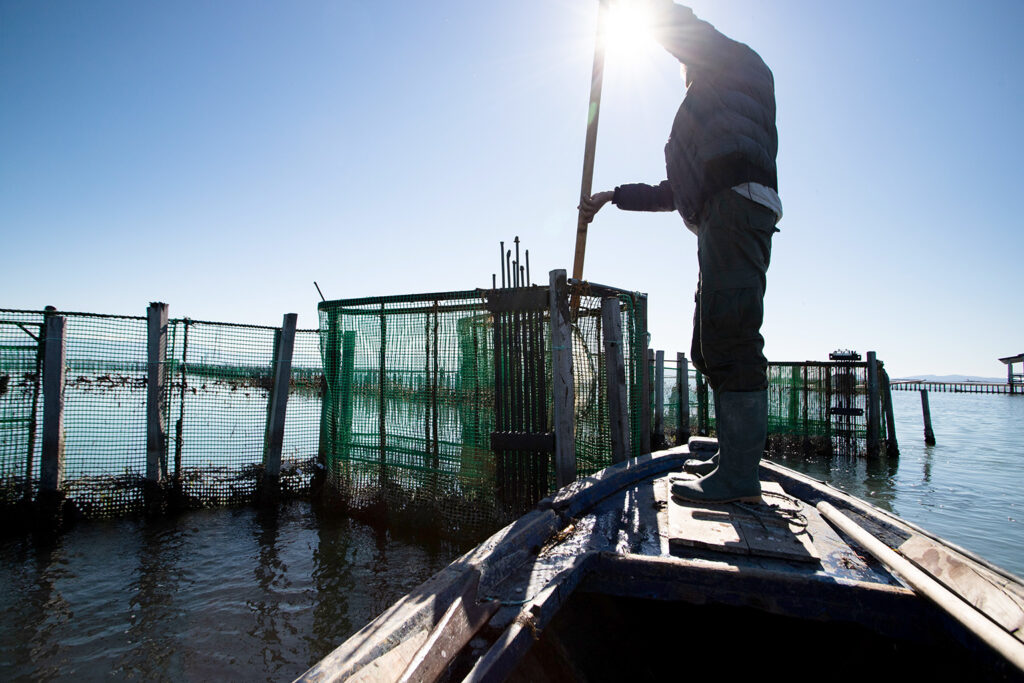
I dedicated my last evening to some Pelican flight shots with the urban background but with no success. It was time to pack and to move on to the next station of the mission, Amvrakikos Gulf, two hours north of my position. My travel to Amvrakikos started with a sad sighting: an Otter killed by a car while it was trying to move between a drainage channel to the main wetland. One could say that roadkill animals are unavoidable, and to some extent this is true, but especially in biodiversity-rich areas potential corridors and hotspots should be located and mitigation measures should be taken for the safety of both car drivers and animals. After a short stop at the island-town of Etoliko for a few more fish-market shots and a visit to the “primordial” western Messolonghi wetlands, I hit the highway.
I arrived at Amvrakikos gulf at midday, with quite bad light conditions. I used these photographically speaking dead hours to learn my way around, since I haven’t visited the area for years, and also, I bumped into some fellow birdwatchers that had set their telescope near the island of Koronisia, probably the best sea-watching spot of Greece. Birdwatching is still not very popular in Greece and usually when people see persons with telescopes they stare like seeing something really extraordinary. This is not the case at Koronisia (an island in the heart of Amvrakikos, that can be reached by road) where locals are generally used to the “crazy people with binoculars”.

Ecotourism plays an important role in the acceptance of birds, especially the fish-eating Pelicans, with Kerkini Lake being a tremendous example of a change of attitude. What I witnessed in Amvrakikos is that fishermen generally don’t have a problem with the Pelicans and they even admire them while they don’t like the Cormorant, which can be seen in greater numbers, and according to fishermen can inflict great damage to fish stocks. Special anti-cormorant nets have been placed above channels where fish gather. This net, if not placed firmly, can work as a trap for cormorants and other birds which get entangled and finally die. Non-lethal alternatives should be researched and applied by the fishermen in cooperation with relevant scientists.
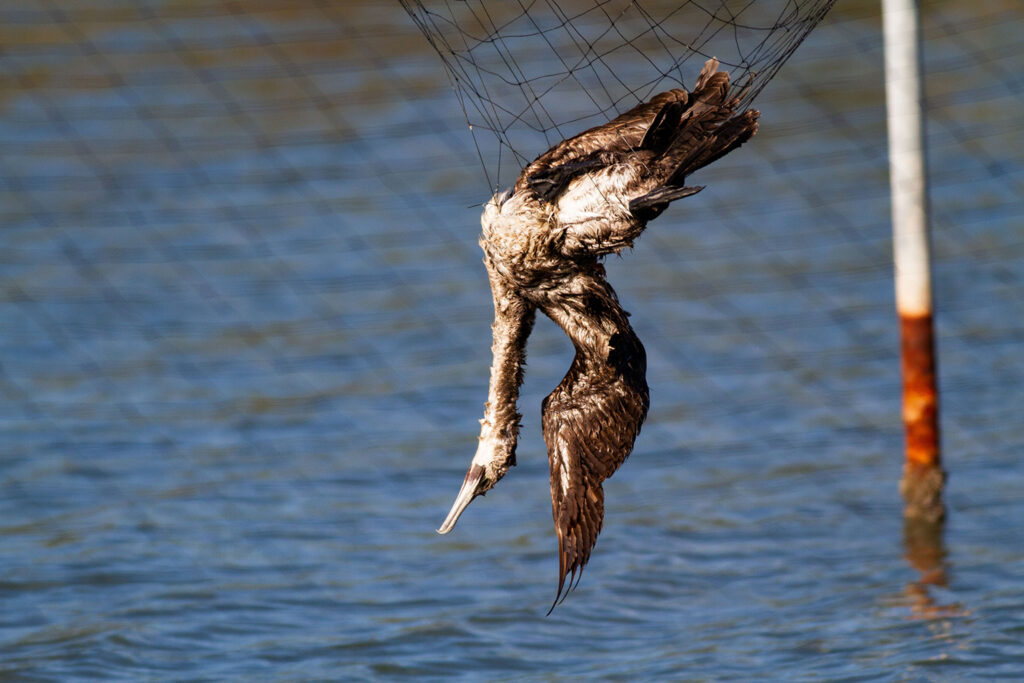
My first afternoon at Amvrakikos was approaching and I had already planned where I would see the sun setting. Panos Haskis, field ornithologist of HOS at the area, has informed me that some days ago he had found a dead Pelican due to a collision with an electrical wire. The location was under a “killer line” in the middle of the wetland where Panos has found dead Pelicans again in the past. I arrive at the spot one hour before sunset and I started taking shots of the dead bird. I also discovered a dead Yellow-legged Gull under the electricity pole that probably killed the Pelican. Even though sad, the dead Pelican was a nice finding (thank you Panos) and I had to make the best pictures possible so that the death of the poor animal was not in vain. After changing many angles I was still not satisfied, so I took the decision to visit the spot again the next morning.
While I was trying to sleep early, the dead pelican kept popping up in my mind. It was a bitter-sweet feeling since I imagined it flying above the wetland and then crashing onto the wires. So I woke up really early and I had set my tripod next to the lifeless body of the bird well before sunrise. As the sun was lighting up the horizon and with the use of a fill-in flash, I finally got the shot I wanted, where the pelican was lying dead but at least looking peaceful in the twilight. I paid my last respect to the bird and I left the area to meet Panos.
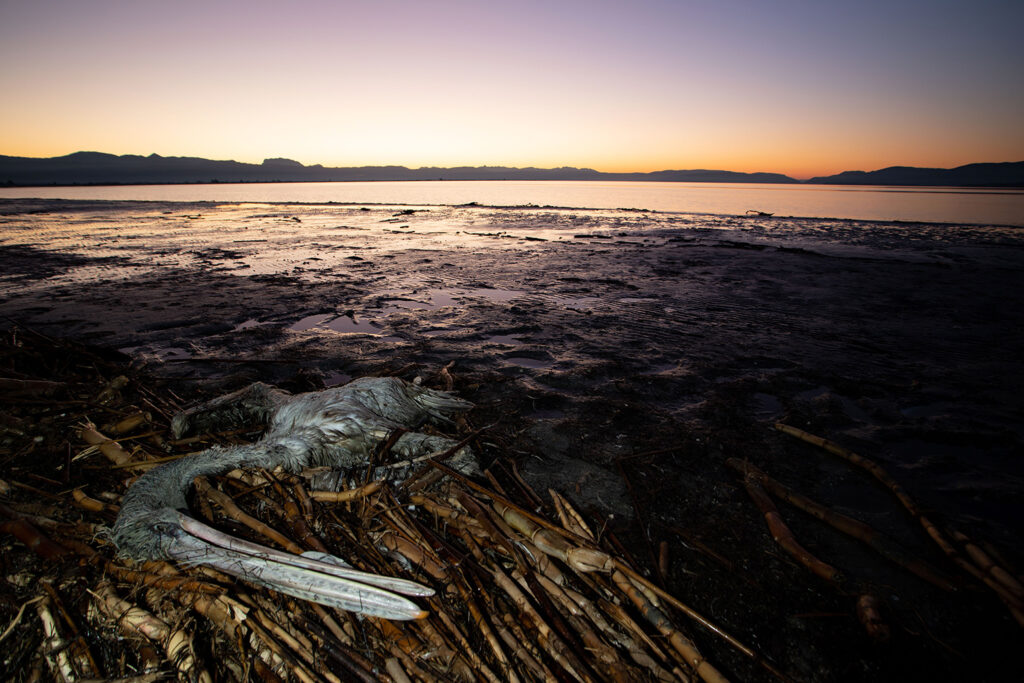
Panos is almost my age and he was born and raised in the area with a great passion for the protection of the wetland. I found him watching one of the two colonies (counting 150 breeding pairs in total) of Dalmatian Pelican of the area, deep inside the lagoon of Tsoukalio. After spending some moments enjoying the colony life through the scope, we started our tour around the wetland. Almost immediately Panos spotted another sad finding. A Loggerhead Sea Turtle (Caretta caretta) was lying dead near the coast next to the lagoon. The carcass was so fresh that in the beginning, we were not sure if the animal was dead or not. But after I put my waders on and approached it, I noticed that there were multiple round holes on the cell of the animal, like they were made by bullets or a spear-like object.
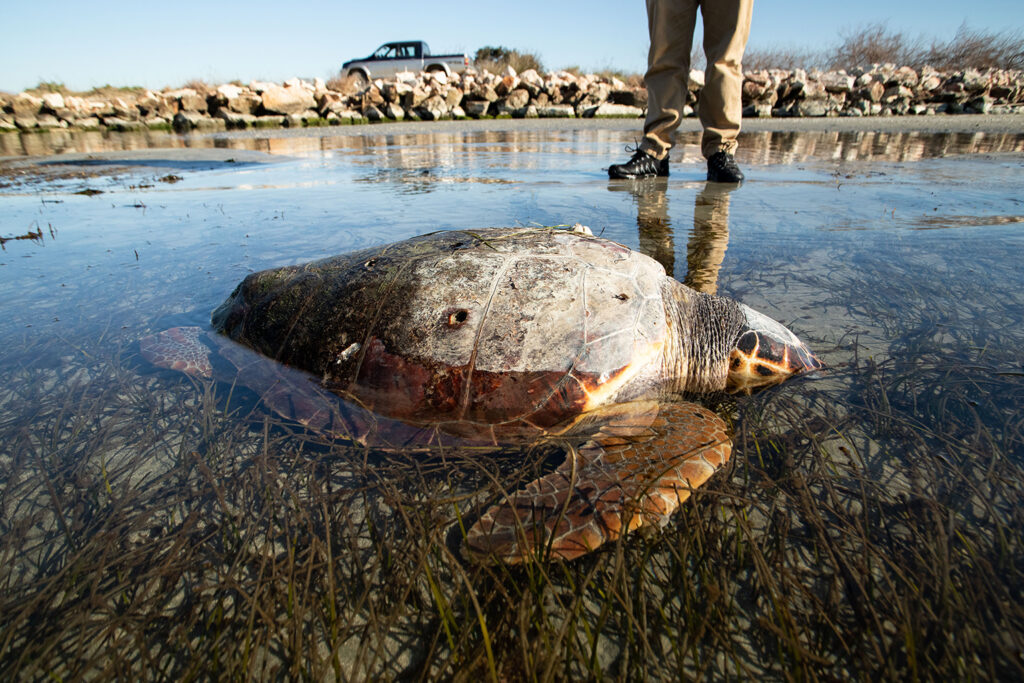
Sea Turtles are considered by a small portion of fishermen as competitors and human-induced kills (besides the quite often bycatch) are recorded every year. This sighting reminded us that out there, there is still an ongoing conflict between (some) humans and nature. Since the turtle was half in water and I don’t own underwater housing, I used the small aquarium that I had brought with me to keep the water out and so I took some split shots.
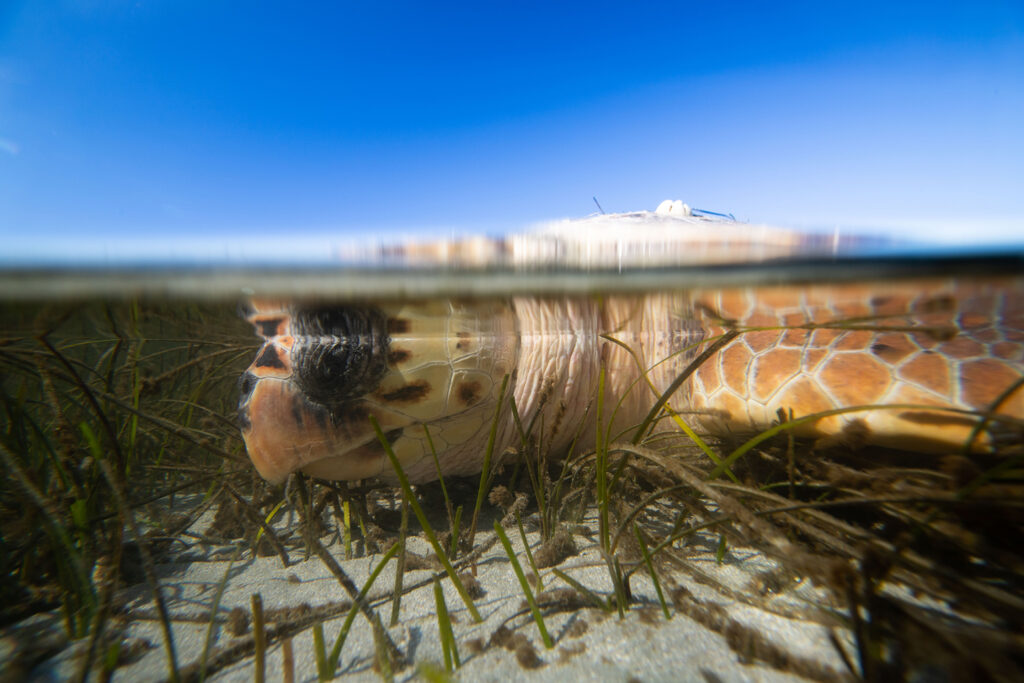
After notifying the management body of the area about the dead turtle we continued our way. Panos proved to be an excellent guide and the rest of the day we shot some nice landscapes, worked with local fishermen (gathering some Eels from their ivari traps), and also shot some nice Pelicans at dusk with the Koronisia village in the background.
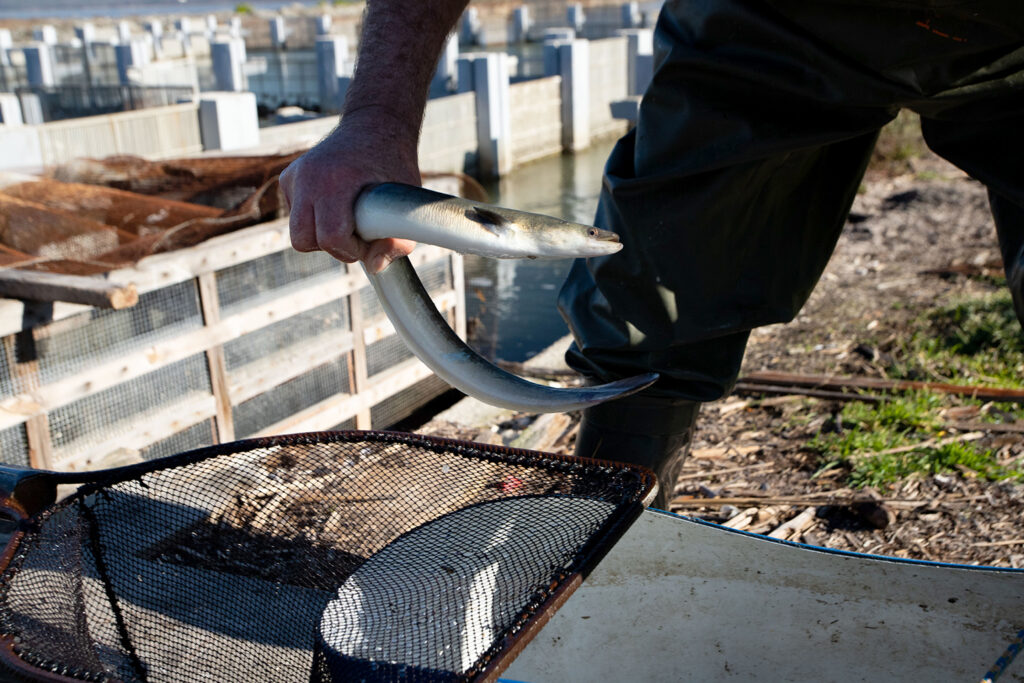
The next day I continued my trip around Amvrakikos, shot some more landscapes, and witnessed the abandonment of orange cultivation that the area was famous for, to the more profitable (but also more water demanding) kiwi plantations.
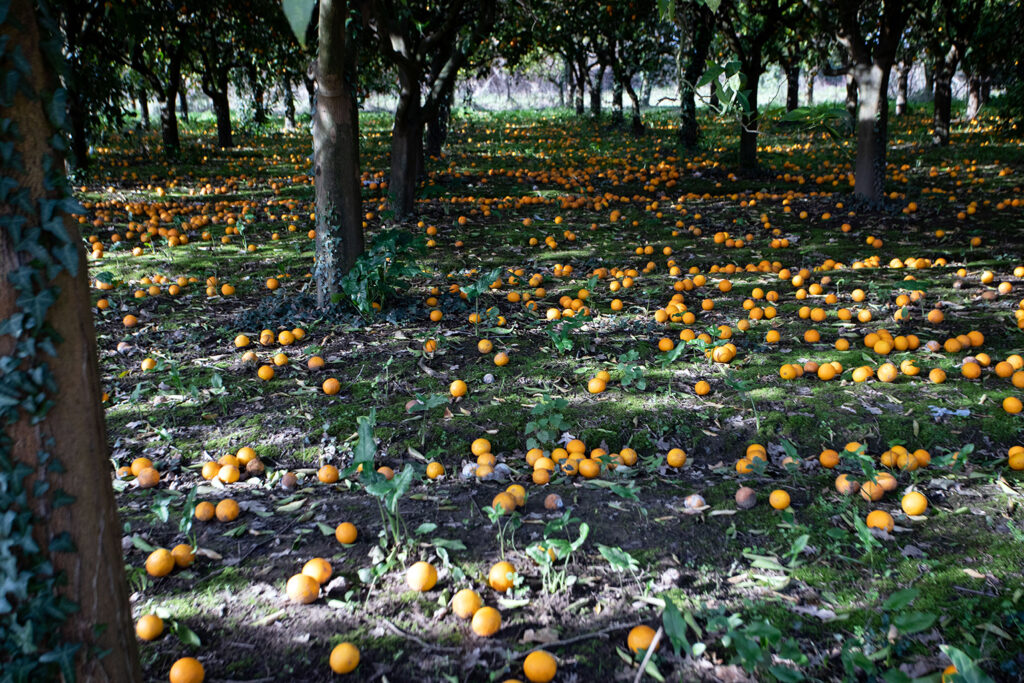
Also, this day was probably the most successful with the Pelicans, since early in the morning a group of 6 bids allowed me some relatively close but also some low-angle shots, while in midday another group that was trying to land at a pumping station gave some nice flight shots.
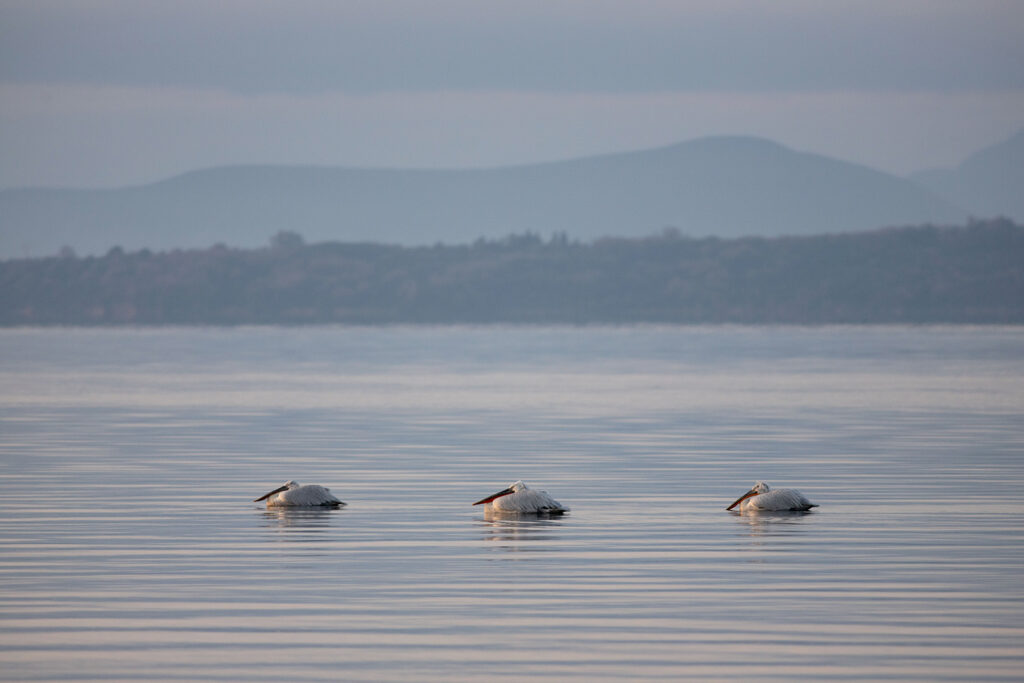
I was quite satisfied but I wanted to have some more material of the people of the wetland. So while I was having dinner at one of the most famous fish taverns in the area, I asked the owner if he knew of any fishermen, I could go with to document the fishing procedure. Without any hesitation, Demos, the tavern owner, called some friends, and that way I ended up spending my last morning with two amazingly friendly fishermen pulling their nets from the lagoon of Logarou. This time the nets were relatively empty but the fishermen kept their spirit high since they believe in the power and wealth of the lagoon. On our way back to the small harbor I finally got the fisherman image I wanted, using some flash and keeping the human as a silhouette, a tribute to the anonymous fisherman, human and aerial, that tries every day to earn a living from the wetland in a sustainable way!
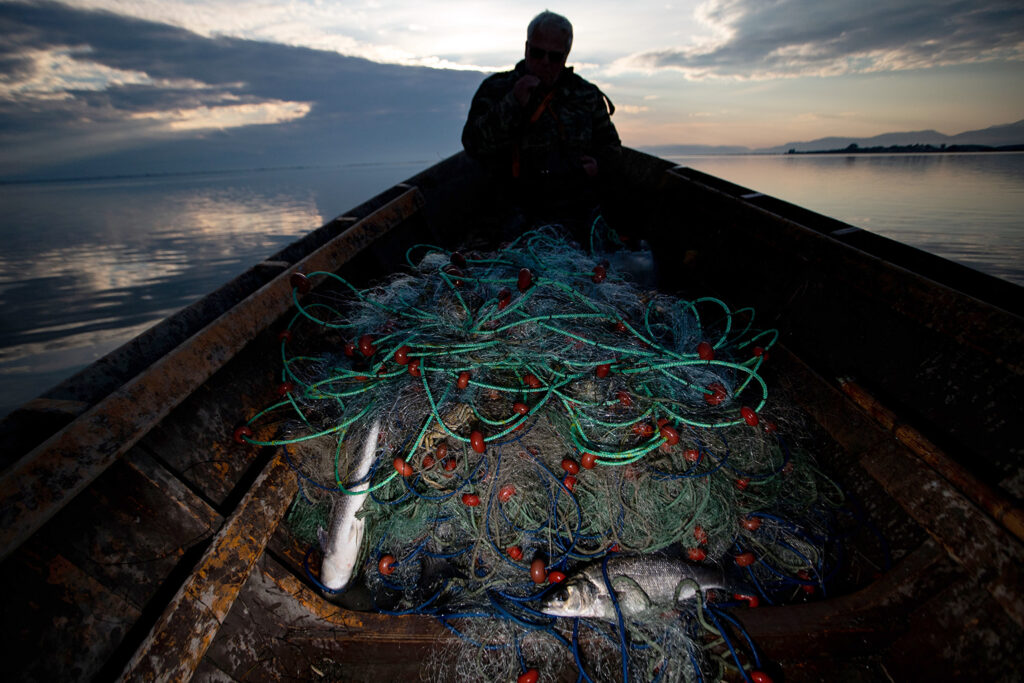
From the bottom of my heart, I want to deeply thank all the persons that helped to execute this mission, Manolia, Aris, Nikos, Panos, Christina, Dionisis, Christos, Demos, the kind hearted noble fishermen of Messolonghi and Amvrakikos, and of course the amazing Dalmatian Pelicans!